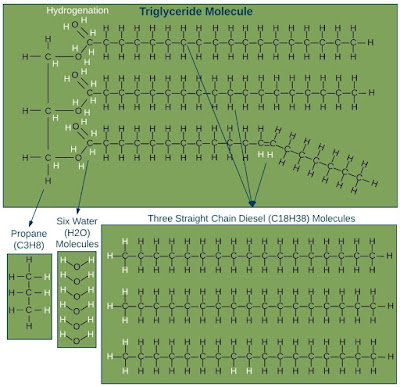Piteå Tall-Oil Biorefinery
Nombre / Name
|
Piteå Tall-Oil Biorefinery
|
Empresa / Company
|
SunPine (www.sunpine.se)
|
Localización / Location
|
Piteå (Sweden)
|
Categoría / Category
|
Comercial / Commercial
|
Estado / Status
|
Operación / Running
|
Plataformas / Platform
|
Aceites
/ Oil
|
Materia prima / Feedstock
|
Tall oil crudo / Crude tall-oil
|
Producto / Product
|
Tall diésel crudo,
bio-oil y colofonia / Crude tall diesel, bio-oil and rosin
|
Puesta en marcha /
Start-Up
|
Abril 2010 / April 2010
|
Figure 1. Piteå Tall-Oil Biorefinery
(extracted from Reference 3)
La idea de extraer diésel del tall-oil crudo (CTO) proviene de Lars
Stigsson, que estudió cómo hacerlo posible en 2005, y, el químico Valeri
Naydenov, que preparó un modelo para el proceso. Lars Stigsson promocionó la
idea y los propietarios (KIRAM AB, Preem AB, Sveaskog, Södra Skogsägarna)
fundaron SunPine en 2006. La planta de producción a escala industrial (20
metros de alto, 4 niveles y 35 metros de ancho) fue puesta en marcha en 2010 y,
ahora, tiene una capacidad aproximada de 100.000 m3 de tall diésel
crudo al año. En mayo de 2015, se anunció que SunPine y la empresa química
Lawter planeaban expandir la planta para producir colofonia a partir de otoño
de 2015. De esta manera, SunPine fabrica tres productos diferentes en la biorrefinería:
tall diésel crudo (materia prima para biocombustibles), bio-oil (fuel oil
renovable que se usa en la industria papelera) y colofonia (materia prima para
tintas y adhesivos). The idea of extracting diesel from Crude Tall-Oil (CTO) came from
Lars Stigsson, who studied how to make this possible in 2005, and, the chemist Valeri
Naydenov, who prepared a model for the process. Lars Stigsson promoted the idea
and the owners (KIRAM AB, Preem AB, Sveaskog, Södra Skogsägarna) found SunPine in
2006. The full-scale production facility (20 meters high, 4 levels, and 35
meters wide) was started-up in 2010 and, now, it has a capacity of approximately
100,000 m3 of crude tall diesel per year. In May 2015, it was
announced that SunPine and the chemicals company Lawter plan to expand the plant
in order to produce rosin since autumn 2015. In this way, SunPine manufactures
three different products in the biorefinery: crude tall diesel (raw material
for biofuels), bio-oil (green fuel oil used in the paper industry) and rosin (raw
material for printing inks and adhesives).
El CTO es un subproducto de la industria papelera, por tanto, no hay
competición con la cadena alimentaria. Después de la digestión (proceso Kraft),
el jabón cálcico se separa del licor negro y se acidifica con ácido sulfúrico
para generar el CTO, cuyos principales componentes son ácidos grasos, ácidos
resínicos y elementos neutros (por ejemplo, esteroles). CTO is a by-product from
the pulp and paper industry, therefore, there is no competition with
manufacturing of foodstuffs. After the digester (Kraft process), the calcium soap
is separated from the black liquor and acidulated with sulphuric acid into CTO,
whose main components are fatty acids, resin acids and neutral elements (for
instance, sterols).
El proceso de SunPine comienza cuando el CTO se mezcla con biometanol y
ácido sulfúrico (catalizador) para producir una reacción de esterificación. En
una torre de destilación a vacío, la mezcla obtenida se fracciona en tall
diésel crudo (producto principal) y bio-oil/tall-oil pich (subproducto). Otros
constituyentes de mayor valor añadido (colofonia, esteroles, beta-sitosterol,…)
se extraen del subproducto posteriormente. La producción de diésel renovable
tiene lugar en dos fases. Después del proceso de extracción en la biorrefinería
de Piteå, el tall diésel crudo se almacena en un gran tanque en el puerto de
Haraholmen antes de ser embarcado hacia Preem en Gotemburgo. Allí, se lleva a cabo
un refinado final mediante un tratamiento bajo condiciones de alta presión de
hidrógeno (hydroprocesado) para obtener diésel renovable de alta calidad (HVO).
The SunPine
process starts when CTO is mixed with biomethanol and sulphuric acid (catalyst)
to produce a reaction of esterification. In a vacuum distillation tower, the
obtained mix is fractionated to crude tall diesel (main product) and bio-oil/tall
oil pitch (by-product). Further valuable constituents (rosin, plant sterols, beta-sitosterol,…)
are extracted from the by-product later. The production of green diesel takes
place in two stages. After the extraction process in the Piteå biorefinery, the
crude tall diesel is stored in a large tank at the harbour on Haraholmen before
it is shipped to Preem in Gothenburg. There, it is further refined through
treatment under high pressure hydrogen (hydroprocessing) to become high-quality
renewable diesel fuel (HVO).
_________________________________________________________________________________
REFERENCIAS / REFERENCES
1 www.sunpine.se/en/ (accessed on 19th
January 2016).
2 “A sustainable future for SunPine”. Available on line: www.svebio.se/sites/default/files/SunPine%20information%20-%20Eng.pdf
(accessed on 19th January 2016).
3 “SunPine BiorefinerySecond generation biofuel”.
Available online: http://www.ieatask33.org/app/webroot/files/file/minutes_and_presentations/Pitea_Oct2011/Site%20visits/SunPine%20presentation_eng.pdf
(accessed on 19th January 2016).




